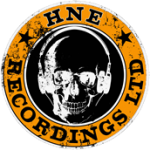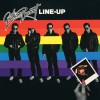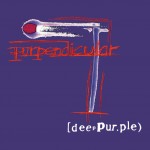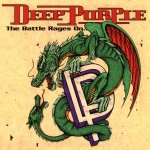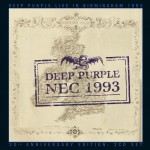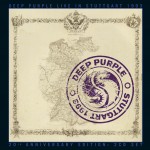Deep Purple
DEEP PURPLE “Purpendicular” [+ 2 bonus tracks] (1996)
CATALOGUE NUMBER: HNECD 041
DEEP PURPLE “The Battle Rages On/Come Hell Or Highwater” [2CD] (1993)
CATALOGUE NUMBER: HNECD 037D
DEEP PURPLE “Live In Birmingham 1993″ [2CD] (1993)
CATALOGUE NUMBER: HNECD 025D
DEEP PURPLE “Live In Stuttgart 1993″ [2CD] (1993)
CATALOGUE NUMBER: HNECD 024D
DEEP PURPLE “SLAVES AND MASTERS” (1990)
CATALOGUE NUMBER: HNECD 021
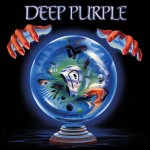
The illustrious, chequered and colourful career of Deep Purple goes back to the psychedelic late 1960s with a band called Roundabout, then mooted to feature a revolving line-up of musicians around a core nucleus of keyboard maestro Jon Lord, guitar-slinging magus Ritchie Blackmore and former Searchers drummer Chris Curtis. By the time that 1968’s debut “Shades Of Deep Purple” was released, the line-up had coalesced to feature drummer Ian Paice – now the only original member and constant figure in their 45 year career. From 1968 until an untimely demise in March 1976 at the Liverpool Royal Court, Deep Purple did indeed feature what seemed like a revolving door of musicians, with many considering the “Mk2” line up of Blackmore, Paice and Lord - joined by bassist Roger Glover and singer Ian Gillan (both formerly members of Episode Six) - to the be the definitive version of the band. Despite the success of the “Machine Head” and “Made In Japan” LPs (both issued in 1972), lead singer Ian Gillan quit following 1973’s “Who Do We Think We Are”, playing his final gig with the band in Japan that July, with Purple losing bassist Roger Glover in the process. The band came back stronger than ever, with both “Burn” and “Stormbringer” in 1974, now fronted by David Coverdale, giving Purple a more bluesy and soulful edge. Sadly, the “funkier” elements of “Stormbringer” were too much for errant lead guitarist Ritchie, who quit in April 1975 to form Rainbow with Ronnie James Dio. Replacing Ritchie with former James Gang guitarist Tommy Bolin for the fine “Come Taste The Band” record in 1975, Deep Purple soldiered on for one final world tour before unceremoniously grinding to a halt at the end of their 1976 UK jaunt.
By the beginning of the 1980s, all of the principle members of Deep Purple were having large degrees of success; David Coverdale, joined by Jon Lord and Ian Paice in Whitesnake; Ian Gillan fronting his own eponymously titled band; and Ritchie Blackmore with Roger Glover in Rainbow, who could now headline the Monsters Of Rock festival, the first of what would be many rock events held at Castle Donington racetrack in the UK. Despite the huge successes each act were enjoying, there still appeared to be demand for the music of Deep Purple, demonstrated by the huge chart success of the TV advertised “Deepest Purple” compilation LP, a record exclusively featuring music from the Mk2 and Mk3 line-ups of the band. This was no doubt assisted by current success of the “New Wave Of British Heavy Metal” during the late 70s and early 80s, a movement that along with Led Zeppeli and Black Sabbath, Deep Purple had been instrumental in inspiring.
Rumours of a Deep Purple reunion flew thick and fast when Ian Gillan scuttled his own band in 1982 during the tour to support his “Magic” album, rumours which were put paid to when he somewhat incongruously joined Black Sabbath in 1983 for the “Born Again” album. In turn, Whitesnake were going from strength to strength, headlining the Monsters Of Rock festival in 1983, and the positive inroads Ritchie Blackmore’s Rainbow were making in the all important and highly lucrative US market gave no indication that a reunion was likely. But then in 1984 it was announced that the Mk2 line-up had indeed reformed, and would go on to enjoy a thoroughly successful comeback with that year’s “Perfect Strangers” LP. This was followed by a world tour that carried them into the summer of 1985, filling arenas, stadiums and festivals across the globe. Whitesnake carried on without Jon Lord, finding even greater worldwide success with 1987’s eponymously titled album, and Rainbow effectively came to an end following a handful of Japanese dates in early 1984. In many respects, Ritchie Blackmore was the lynchpin in any such reunion, but what led to Rainbow splitting and Deep Purple reforming, with Ian Gillan handling the lead vocals? Ritchie explained to Kerrang!’s Geoff Barton, “Joe Lynn Turner was into ballads, and I was going through a melodic phase - but the trouble was, every time I wanted to play a real hard rock song, Joe couldn’t quite manage it. Don’t get me wrong, Joe’s a great singer, but he’s too smooth to sing rock ‘n’ roll.”
Although the guitarist had toiled for nine years and seven studio albums to make Rainbow the success it was, according to Ritchie, “I feel that, although Rainbow did some good stuff, it didn’t ever have the identity that Purple has.”
It’s no secret that one of the reasons Gillan had originally left Purple over a decade earlier was due to a somewhat fractious relationship with Ritchie, but evidently the hatchet had been buried in creating the comeback LP, as Ritchie told Mick Wall, “[Ian Gillan] will come up with melodies and lyrics to things I’ve written which I would never have thought of. That’s part of the chemistry and magic of Purple. Nobody has a voice like Ian Gillan’s.”
“Perfect Strangers” was a great comeback record, and a commercial success. But despite Ian Gillan’s claim that 1987’s follow up “House Of Blue Light” was, “Without doubt it’s my favourite album since “Fireball,” the second MK2 reunion record seemed half-baked by comparison. Following the seemingly obligatory double live album in 1988, there was the shock announcement that Ian Gillan had been fired from the band.
Jon Lord explained to Raw magazine, “I don’t think Ian was enjoying it anymore, but I think he was finding it increasingly difficult to deal with Ritchie… Ritchie is Deep Purple. He’s the heart and soul of the band in my opinion. He has to be accommodated because he is our secret weapon.
A number of singers were auditioned for the vacant vocal mic, including American Tony Brock, the ex- singer from Scottish band Strangeways, and former Lion and Tytan front man Kal Swan, and according to Colin’s Hart’s tome on his career working for Deep Purple and Rainbow, “A Hart Life”, Australian rockers Jimmy Barnes and John Farnham were under consideration too. According to Jon Lord, “we wanted Jimi Jamison from Survivor and we couldn’t get him.” But what was probably more surprising at the time was that Gillan’s successor in the band was to be former Rainbow front man and lead singer, Joe Lynn Turner.
Despite this, Ian Gillan seemed more saddened than bitter by the split; “There’s too much dear to my heart to get involved in a slagging match because I’ve basically still got a lot of affection for the guys.” When asked why he was fired, “The answer is I don’t really know.” Since 1972’s “Machine Head”, the band had often recorded in less than conventional locations, using mobile studios to make their albums. Using a “proper” studio to record their next record was one of Ian’s suggestions. As Gillan told Kerrang!’s Neil Jeffries in a frank interview published in July 1990, “During the last meeting before I was invited to leave Deep Purple, Jon Lord said, ‘The thought of recording in New York City fills me with dread’. I said, ‘Bloody hell! Are we a rock band or what?!?’” Ian did seem somewhat at a loss to explain what had led him to being fired from the group, “I must admit to being a little disenchanted with the direction – if you can call it ‘direction’ – that the band was staying in rather than going in, but we could have got over that…” When pressed about his successor, Gillan offered, “I don’t know. It’s difficult… I don’t know how Joe Lynn Turner is going to sound, even if they’re doing anything other than ‘Highway Star’, ‘Woman From Tokyo’… I wish the guy luck.” Sadly, Ian seemed at a loss, “I can’t figure it. I just can’t figure it. Other than what I said – or the fact that I banged my fist on the table a couple of times and shouted!”
When asked about Ian Gillan, Roger Glover told Kerrang!’s Neil Jeffries in an interview published in October 1990, “We are good friends and we always will be good friends. We have this pact that we don’t talk about Purple. I think that’s a bit of a shame because him not knowing has caused him to start speculating as to why he was given the elbow. It was nothing to do with his behaviour, or the manager… It was definitely a musical reason… It was a decision taken by all of us in the band, however painful that was.” But Roger also added , “he is very much his own voice, a unique person, a unique talent, and completely irreplaceable. In many ways, I miss him a lot.” In fact it hadn’t been long since the pair had released the “Accidentally On Purpose” album as “Gillan/Glover”.
On the subject of Gillan’s recent departure, Jon Lord’s summation to Kerrang!’s Steve Mascord was, “We felt he was distancing himself more and more from the band… we decided he should terminate his employment with us because we didn’t think he was pulling in the same direction. It’s a sad fact, but true.” However, there did appear to be total respect for their former, and future, lead screamer, “I’m not going to be spiky about Ian because I think he’s a highly talented man. He’s number one in a field of one as far as I’m concerned.”
After the relative failure of 1987’s “House Of Blue Light”, and a new multi-million dollar deal with BMG/RCA for their next album, there was a lot of pressure on Deep Purple to deliver the goods as effectively as they had done on “Perfect Strangers”. As Roger Glover told Kerrang! magazine on the eve of the release of the new LP, “I thought the ‘…Blue Light album was thoroughly disappointing… There’s hardly one redeeming thing about it. I thought it was a great big wooden mess.”
Although Joe Lynn Turner himself admitted that, “it’s becoming Deep Rainbow. They didn’t like that at all, Roger and those guys.” However, following Joe’s initial audition, Roger did reckon, “I’ve got to admit the guy really impressed me.” And following an initial jam session, running through the Joe South/Jimi Hendrix standard ‘Hey Joe’, “Things just started to happen, you could tell, the band kicked in. Things started to really ignite and within 10 or 15 minutes we were writing songs!”
As way of explanation, Joe said that, “Ritchie would mostly lead it… he’s the cornerstone, he’s the riffmeister, he was the one that gave them that sound.” And as if to confirm this notion, “Most of the time Ritchie instigated all of these decisions.”
Although not necessarily recapturing the glory days of “In Rock” or “Burn”, “Slaves And Masters” was a fine commercial hard rock record, far from being the failure many had predicted. Certainly in his October 1990 article, Neil Jeffries reckoned, “Just like “In Rock”, “Burn”, “Come Taste The Band” or “Perfect Strangers” it sounds like a band making a fresh start.” A statement that at least pleased bass guitarist and producer Roger Glover, who was very positive for this “Mk5” line-up of the band, “I don’t think the test is how well Joe performs the old songs, it’s how well he performs the new songs and how much of a career we forge from here.”
Singer Joe Lynn Turner was completely confident in the strength of the new opus, “It’s already a success to us. It’s a great album whether it sells one copy or 10 million.” There’s no denying Joe’s passion and conviction for his new band, “The bottom line is that I’m here to do the best job I can for Deep Purple. I love the past and I’m excited about the future. Damn the torpedoes, and the slings and arrows of outrageous fortune.”
A notion backed up by Morat’s KKKK review in the same issue of Kerrang!, “As if you need telling, oh ye of little faith, Deep Purple have come up with the goods yet again, and although it takes a while to grow on some of you, there is now doubt it will.” Going so far as to say, “ Joe Lynn Turner proving once and for all that he is an asset to the band while the legendary Ritchie Blackmore deals with six strings the way only he can.”
“I’m 95 per cent happy with it,” reckoned Jon Lord, “but the five per cent is that it doesn’t have a ‘Speed King’ or a ‘Gypsy’s Kiss’, or a track like ‘Burn’.” Joe Lynn Turner added, “We were really hoping that people would listen to the album. The album is credible, it sounds like Purple. Yeah, it’s a different singer, but at the same time Rod Evans was a different singer, people move on, but at the same time does the album stand up? Yeah, it stands up. A lot of people were saying it was Deep Rainbow and we were more concerned that we had a quality recording and we put a lot of work into it.” Understandably on the defensive, and in lieu of an explanation, the singer stated, “It’s not as forced as the Rainbow albums… This album was the other side of me – dirtier and nastier…” However, “If I hear ‘Deep Rainbow’ again I think I’m gonna puke. Think of something else… I think people should judge the record on its own merits.”
At the time of release there was no doubt that the band and label had anything but total faith in the new record, coupled with the release of two singles, ‘King Of Dreams’ and ‘Love Conquers All’, plus a world tour. Although more fans must’ve been won over by the band playing four nights at London’s Hammersmith Odeon as opposed to Wembley Arena, the band only played eight dates across the whole of the States, which had previously been one of their most lucrative markets. But as Joe Lynn Turner explains, “there were a lot of places in the States that we cancelled… I think the Gulf War was on, and the economy was kind of upside down… But everybody cancelled on that tour and we were the only band that stayed true to touring so we did a lot of great business because we were the only game in town.”
The protracted tour instead took in firmer Purple strongholds such as Sweden, Germany and Japan, but despite the downturn in the States, they also managed to visit more exotic locales such as Singapore, Brazil, Poland, Greece and Israel.
Reviewing the German leg of the tour, Kerrang!’s Howard Johnson confidently reckoned the show was “an event par excellence. Not a wayward trip down memory lane. Not a disgraceful continuation of a long-gone legend either, but actually a bona fide rock ‘n’ roll band… performing their craft with consummate professionalism and convincing heart.” Deep Purple were genuinely making, “a valid rock ‘n’ roll musical statement.”
Whereas the Mk2 line-up shows had heavily relied on the “Made In Japan” album for their running order, no less than seven of the nine songs on “Slaves And Masters” were aired live on the tour. They also managed to resurrect classics such as ‘Burn’ and Rainbow’s ‘Long Live Rock ‘n’ Roll’, numbers that you could not imagine Ian Gillan happily agreeing to sing. Roger Glover: “Because this album was done in such a live way from jams and stuff – that more of it should be performable.”
And according to Jon Lord, “One suggestion I made for Joe – and the other guys seem to have agreed – was for him to take away everything we’ve done and choose a handful of songs for himself, that he wouldn’t mind doing.”
Not that Joe Lynn Turner would have had any issue with singing any of the old classics, “Album after album they were absolutely my favourite band… I never heard such hard rocking’ blues kinda stuff; song with such good twists. Which is what we’re trying to do now.”
The Union’s and Thunder’s Luke Morley caught the tour when it hit Tokyo, Japan. “On the day we [Thunder] arrived for our first ever visit to Japan, we were invited to see Deep Purple at the Budokan. As they’re one of our favourite bands, and because the Budokan had had so many fantastic live albums recorded there, we didn’t hesitate!” How did the Slaves And Masters version measure up to previous incarnations? Luke had first seen the band on 1974′s “Burn” tour, “The thing I remember most of all was the clarity of sound - I’d seen Purple a few times over the years, but they’d never sounded as crystal clear. We battled the jet lag long enough to pop backstage and say hello, although disappointingly Ritchie didn’t come into the green room…”
Even as early as the October 1990 release of the album, Roger Glover was suggesting he’d like to “do a bit of work to some of our jams, a bit of editing, get Joe in and write songs over them, then do a whole album of just jams.” At the end of the tour, following a final gig in Tel Aviv, the band began work on a follow up, which as far as Joe was concerned he was very much a part of. As Joe told Mike Eriksson, “I don’t know why they fired me. We were recording in a studio in Woodstock when this happened.” Was Joe a bad fit with Deep Purple? “They think that they can rest on the legend that everything will take care of itself. I don’t think that that is a healthy attitude to have. It’s removed from reality.”
According to Joe, one of the possible problems was a resistance from the hardcore fans to anyone other than Ian Gillan fronting the band, “I think they just want to live in the past. A lot of them… don’t realise that today is 1991.”
Glover explained to Neil Jeffries, “I have nothing against Joe personally I just thought it was a wrong move.” Succinctly, but unsurprisingly, Roger surmised that, “I thought the Deep Rainbow criticisms would be flying thick and fast.”
What was Joe’s reaction to the split? It didn’t automatically appear to be the age old musical differences raising their ugly head. “I mean sometimes that happens, when familiarity breeds contempt, and I think that in ways, looking back, I could have probably tempered my attitude a bit, [but] they could have tempered theirs… the tensions and everything you say can be taken out of context.” Although Joe Lynn Turner had initially been very much a part of the Deep Purple machine when they commenced making a follow up to “Slaves And Masters” in 1992, readying the next record for release in time for Deep Purple’s 25thanniversary, as far as he was concerned, “All they wanted was Gillan, Gillan, Gillan… We did make a great album and the second one was going to be even better.” As early as March 1991 there must have been some doubts from Joe about the future when he told Kerrang!, “If we’re still together I think we’ll come up with something brilliant.”
Was Joe’s departure a shock? “I remember the call coming in and I’d gone to visit my family down in New Jersey from Woodstock, and I got the call saying you’re out of the band, and I was relieved… It was just overwhelming my whole life at that point. And I really just wanted out.”
The singer went on to tell Hubert Allusson, “I completely respect all of the members of Deep Purple, and will always admire them for their incredible contribution to rock and roll history, and glad I could be part of it as well.” But bygones will be bygones, as Joe explained to the Deep Purple Appreciation Society, “I want to emphasize that there is no animosity between myself and the members of Deep Purple. I recently saw them in Las Vegas…and we hung out, hugged and had a few drinks together, Ian and I included.
So what happened next? 1993 would be Deep Purple’s 25th anniversary, and a new album was due to be delivered to BMG. Jon Lord, “We had realised there was only one singer for us, and that was Ian Gillan.” That new album, with the Mk2 line-up featuring a reinstated Ian Gillan in place – for a third time - was “The Battle Rages On”. Sadly, this line-up would not last the duration of their 25th Anniversary tour, but that’s another colourful episode in the 45 year career of Deep Purple.
So has this album stood the test of time? As Joe Lynn Turner told Ray Shasho, “years later people realize that Slaves And Masters was one solid album… People acted emotionally and didn’t really sit and listen.”
Leaving the last word to Kerrang!’s Howard Johnson, “at the end of the day what matters is the bloody music. And believe me, Purple have still got class stamped over every goddamn tune!”
Hugh Gilmour
London 2013
References: Kerrang! issue No 137m Kerrang! Issue No 312, Kerrang! Issue No 331, More Black Than Purple Issue No 32, Colin Hart “A Hart Life”, Luke Morley interview 2013
